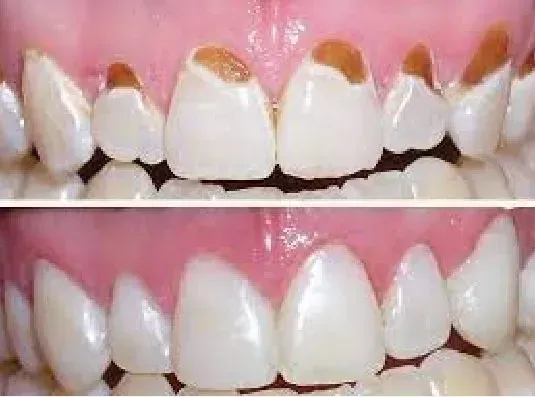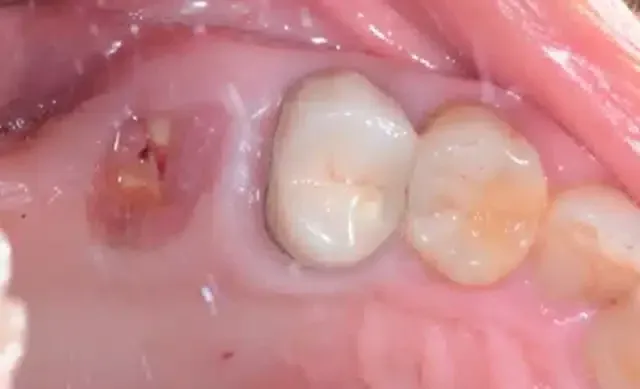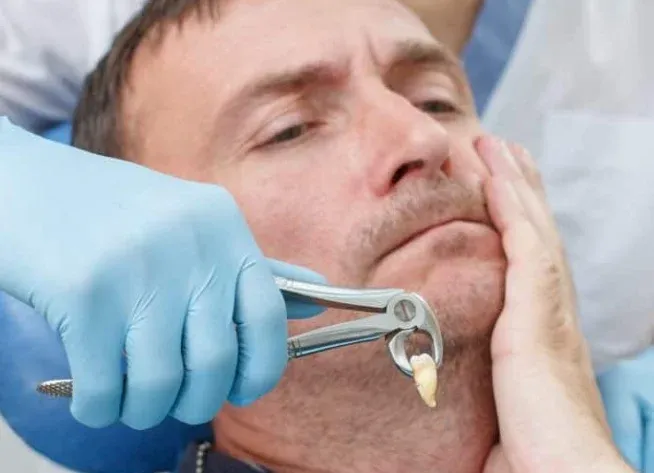Tooth Broke Off at Gum Line: Can It Be Saved? (A Dentist’s Emergency Guide)
Disclosure: This article may contain affiliate links. As an Amazon Associate, I earn from qualifying purchases….
Disclosure: This article may contain affiliate links. As an Amazon Associate, I earn from qualifying purchases. This content is for informational purposes only and does not constitute medical advice. Always consult a qualified dental professional for diagnosis and treatment
What to do if your tooth broke off at the gum line? (Emergency Steps)
First: is this a true dental emergency?
Yes. Even if you feel no pain, you must treat a broken tooth immediately. You must get treatment and see a dentist as soon as possible (within 24-48 hours) to prevent infection.
Here is your immediate treatment plan:
-
Call Your Dentist Immediately: Schedule an urgent dental appointment. Inform them a molar is broken so they can prepare the right treatment options.
-
Rinse Gently: Rinse your mouth with warm salt water to clean the area.
-
Manage Pain: Take over-the-counter pain relievers if needed.
-
Save the Fragment: If you found the part of the tooth that broke off, put it in milk or saliva. In rare cases, reattaching the broken tooth is an option.
-
Cover and Protect the Tooth: A broken tooth exposes sensitive inner layers. To prevent infection and stop pain, you must cover it while you wait for your dental appointment.
DenTek Temparin Max Repair Kit

Why this is your first aid:
- Easy to Use: No mixing required. Just apply the putty to the broken area.
- Instant Protection: Covers exposed nerves to stop pain instantly.
- Temporary Hold: Keeps food and bacteria out until you see the dentist.
Mastermedi Zinc Oxide Cement Kit

If you need a longer fix:
- Professional Grade: Zinc Oxide Eugenol is what dentists use for temp fillings.
- Durability: Hardens better than putty for a stronger seal.
- Versatile: Can also re-cement loose crowns or bridges.
-
Avoid Chewing: Do not engage in chewing with the broken tooth.
What causes a tooth to break off at the gum line?
When a tooth breaks at the gum line, there is usually an underlying reason. A tooth may break from various causes, including trauma or decay.
-
Significant Tooth Decay (The Silent Killer): This is the #1 culprit. Decay weakens the tooth structure from the inside out, leading to symptoms of a broken tooth. A large, old filling can act as a wedge, and eventually, the remaining portion of the tooth gives way. This is often the cause for a decayed tooth broke off at gum line.
-
Trauma or Injury: A direct blow to the face, or biting down hard on something unexpected (like an olive pit or hard candy), can result in a tooth broken below the gum.
-
Grinding (Bruxism): Constant grinding at night can cause a tooth fracture or crack over time, which can eventually break a tooth.

Can a tooth broken off at gum line be saved?
This is the main question, and the answer depends on one factor: how much remaining tooth structure is left and where the break is.
Your dentist will examine your tooth and take an X-ray to determine if the tooth root is intact and if the fracture extends deep below the bone.
The good news: In many cases, yes, saving the tooth is possible.
The primary goal is to save your tooth if possible. Tooth extraction is always a last resort, as tooth loss can cause surrounding teeth to shift.
How to fix a tooth broken off at the gum line? (Treatment Options)
Your dentist has several treatment options and broken tooth solutions to fix your broken tooth. The tooth treatments will depend on the severity of the tooth damage.
Option 1: Root Canal Treatment
This is the most common first step for restoring the tooth pulp. It’s used if the tooth root is healthy, but the pulp (the center of your tooth containing nerves and blood vessels) is exposed or infected. The dentist removes the infected pulp from the inside of your tooth during root canal therapy.
Option 2: Dental Crown
A dental crown (or “cap”) is the most common tooth restoration procedure. After root canal therapy, a “post and core” (a strong anchor) is often built. The crown is then placed over it to protect the entire damaged tooth and restore its strength.
Option 3: Dental Bonding
Dental bonding is ideal for a minor chip or cracked tooth that is not severe. Your dentist can apply a tooth-colored composite resin to restore the shape and protect the tooth enamel.
Option 4: Crown Lengthening Surgery
If the tooth is broken broken below the gum line, your dentist needs a solid surface to attach the crown. This procedure surgically reshapes the gum near the gum line to uncover more of the tooth, exposing enough tooth structure to place the crown.
Option 5: Tooth Extraction (The Last Resort)
Sometimes, the tooth cannot be saved. This happens if the fracture is too deep, if the tooth root itself is cracked, or if there isn’t enough tooth structure left. Your dentist will extract the remaining tooth root.
What are the alternatives to tooth extraction?
If extraction is necessary, you must replace your tooth. The best tooth extraction alternative is a dental implant.
-
Dental Implant: This is the best permanent tooth restoration ($3,000 – $6,000). It functions and looks just like a natural tooth.
-
Dental Bridge: This is a long-lasting dental treatment but can damage adjacent teeth, so it’s essential to fix the broken tooth properly ($2,000 – $5,000).
-
Partial Denture: A removable, less expensive option that can be used to replace a missing tooth and prevent a broken molar on the other side from overwork.
What happens if you leave a broken tooth untreated?
Leaving a broken tooth untreated is a serious risk that can compromise your overall oral health. An untreated broken tooth will:
-
Get Infected: The exposed pulp will get infected, leading to a painful abscess in the jawbone, especially if the tooth is broken below your gum line.
-
Cause Tooth Loss: The infection can destroy the bone supporting the tooth, making the tooth unsalvageable.
-
Damage Surrounding Teeth: Infection can spread to adjacent teeth and gums, especially if the tooth pulp is compromised.
What if my tooth broke off at gum line and there is no pain?
This is a major red flag for your oral health. “No pain” often means the tooth’s nerve is already dead from decay. The infection is silent but still spreading. You must see a dentist immediately to treat a broken tooth and avoid complications.
Cost of fixing a broken tooth at the gum line
The cost varies wildly based on the solution. The cost of treatment for your tooth depends on whether a simple filling or a more complex procedure (like a tooth with a dental crown) is needed.
-
Tooth Extraction: This is the cheapest option upfront ($150 – $400), but you must also factor in the cost of replacing the tooth.
-
Root Canal Treatment + Dental Crown: This is the most common tooth restoration procedure ($2,000 – $4,000).
-
Dental Implant: This is the most expensive but most durable permanent tooth restoration ($3,000 – $6,000).

What’s Next? (Internal Links & Future Smile)
Dealing with a broken molar is stressful. The first step is to get emergency dental care.
[Internal Link 1]
Healing After Treatment: If your treatment requires an extraction, read our guide on what to expect:
Day-by-Day Tooth Extraction Healing Stages with Pictures
[Internal Link 2]
Understanding Healing Tissue: After an extraction, you’ll see new tissue. Learn about the symptoms of a broken tooth and the healing process here:
After Your Tooth is Restored:
Once your tooth is fixed and your mouth is healthy, you might consider enhancing your smile. (Important: Do not use whitening products on a damaged or recently treated tooth, especially if the center of your tooth is affected. Wait for your dentist’s approval).
If you are looking for a safe and effective way to remove stains from your other healthy teeth, our recommended whitening strips are an excellent, enamel-safe option.
Lumineux Teeth Whitening Strips (Enamel Safe)

Whiten without the pain:
- Zero Sensitivity: Uses Dead Sea salt & Coconut oil instead of harsh bleach.
- Dentist Formulated: Safe to use as soon as your dentist approves.
- Fast Results: Visibly whiter teeth in just 30 mins.
🦷 Emergency Toolkit
Quick fix for now, brightness for later:
Conclusion: Summary of Key Points
If your molar broke off at gum line or tooth broke off at gum line, remember these key points:
-
YES, it is a dental emergency. Call your dentist immediately to address any concerns about your oral health.
-
NO, do not assume “no pain” means “no problem.”
-
YES, the tooth can be saved in many cases with a root canal treatment and a dental crown.
-
NO, do not wait. Leaving a broken tooth untreated can lead to abscess, infection, and tooth loss.







